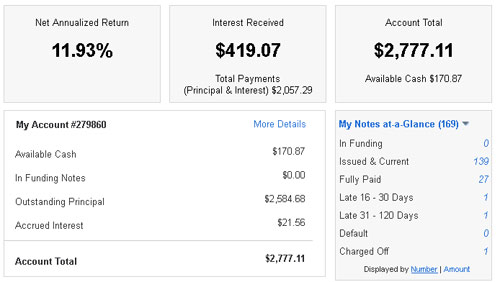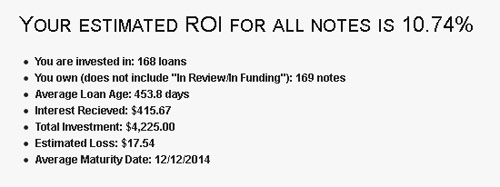My Lending Club account has been kind of hands off the last couple of months, with no new loans being bought or sold. The good news is that my returns are continuing to improve. My returns are now up to 11.93%, getting close to the 12% I said I was looking for a while back. By moving away from purchasing only A and B grade loans, and selectively choosing more C, D and F grade loans I’ve been able to boost my returns significantly. Hopefully next month I’ll be over that 12% hump.
Lending Club continues their steady growth, as they added an another 42.1 million in new loans for April 2012. From SocialLending.net
When you look at the numbers Lending Club issued almost $42.1 million in new loans this month. The total number of new loans was up substantially (over 10%) from last month with 3,230 loans issued. This meant for the second month in a row their average loan size reduced – in April it was $13,019. The total loans issued since inception is now around $612 million and with eight months left in the year it is clear that Lending Club will cross over $1 billion in total loans before the end of the year.
Lending Club has continued to show strong growth, and should be able to cross $1 billion in total loans by the end of the year. I think that goes to show that they aren’t just a flash in the pan. Peer to peer lending is here for the long haul! Prosper has also continued to show growth as well, and may be worth a second look by investors.
Quick Navigation
Social Lending Video Course
Also this month Peter Renton of SocialLending.net has relaunched his peer to peer lending training video course. The course goes over the social lending sphere in depth, talks about how to maximize returns and gives some of Peter’s best investment strategies to help you succeed. The course is well worth the cost, and worth a look if you’re interested in maximizing your returns with P2P Lending.
More Details + Video Overview Of Peer to Peer Lending Wealth System
Returns Now At 11.93%
A week or two ago I started looking at my Lending Club account for 2011 tax purposes. Trying to figure out your taxes when it comes to Lending club can be extremely confusing as the reporting processes can vary depending on how much you’re investing in each loan, how your interest income will be reported, etc. If you’re as confused as i was when I started looking at it, check out my post on Lending Club and taxes.
A couple of months ago I had my first charged off loan. It was disappointing to see my perfect record of no charged off loans go down the tubes, but it wasn’t completely unexpected. With as long as I’ve been investing with Lending Club I would have expected at least 1 or 2 charged off loans a while ago. Here’s a look at my account to date:
- Net Annualized Return of 11.93%: Up from 11.61% in early April, 11.44% in February, all the way back to 10.53% in July of last year. It continues showing progress.
- Number of defaults.. one, with 2 new late: A few months ago now I had my first charged off loan, a Grade B loan. It’s interesting that the loans I’ve had either go late or get charged off have mostly been the higher grade loans. I’ve now got two more late loans, one of them a grade A loan, and the other a Grade D loan. The grade A loan is thankfully almost all paid off already, so even if it gets charged off my losses would be minimal. The grade D loan that’s late is about 1/2 paid off by now, and is already on a payment schedule to hopefully get them back on track. We’ll see.
- Twenty seven loans have been paid off early: Ten were A grade loans, eight were grade B loans, six were C grade, two grade E and one F. Looks like grade A and B loans are more likely to get paid back early, reducing returns. Another reason why I’ve started investing in more higher grade loans.
- My account balance increasing, re-investing returns: I currently have $2,777.11 in my account, with $170.87 of that ready to invest. I’ll get around to re-investing that money soon.
- I’m still diversified by investing across a large number of loans: I’ve had 169 loans, with no more than $25 in each loan. In other words, I’m diversified across a large number of loans, lessening my risk from any one loan going into default or getting charged off.
NOTE: Did you know that 100% of investors who have invested in 800 notes or more had positive returns. Not too shabby, not everyone in the stock market can say that!
What’s Your Actual ROI?

A site that I discovered a while ago that gives what I think is a better picture of the actual ROI you can expect is Nickel Steamroller’s Lending Club portfolio analyzer. Basically the analysis tool with give you an estimated ROI after you download all your notes from your Lending Club account and upload the .csv file. It will go through you notes and give sell recommendations, show duplicate notes and highlight notes that are below Lending Club’s average return (so you can sell them on the secondary platform). It will even give you a fun little map showing where your loans are (see mine above).
In looking at my returns on the analyzer, my actual return according to the site will be closer to 10.74%. It also gives me quite a few sell recommendations, particularly on some of my older lower interest loans that I did when first starting out. Those particular loans tend to be grade A or B, and have interest below 8%.
Evolving Lending Club Strategy
Here’s the basic strategy I’ve been using with Lending Club since I started investing. The strategy has changed a little bit over time to include more low grade loans and a few loans with higher balances.
- Less than $10,000: I believe I’ll still be sticking with mostly loans below $10,000. Lower amounts mean higher likelihood of payback of the loan.
- Zero delinquencies: Again, I may fudge slightly on this one, but I still want it to be very few or zero delinquencies.
- Debt to income ratio below 20-25%: I like to invest in loans where the borrowers have a lower DTI ratio, and preferably have higher incomes. I’ll try to keep this as is.
- Good employment history: I like loans with a decent employment history of at least 2 years, and a decent income.
So that’s what I’m doing with my Lending Club portfolio right now, and how I’m investing.
Not ready to invest, but looking to consolidate debt or pay off a high interest credit card? You might want to consider borrowing from Lending Club. Check out my post on borrowing from Lending Club.
Are you currently investing in Lending Club? How are your returns looking? Tell us in the comments!




Well done Peter. Your returns are excellent and I continue to be impressed with the number of late loans in your portfolio especially since you have been investing for quite a while. And thanks for mentioning the video course. I have had some great feedback on it already from investors.
Very nice post. I am not very familiar on that subject, but after reading this post, I believe I’m gonna check it out a little more. Thanks !
I couldn’t find in your post if you mentioned the percentage of failed loans.
Peter, I have been doing a lot or reading on Lending Club after your post a few days ago. Would you recommend that someone open a No-Fee IRA ($5K beginning balance) or do you think it is better to start smaller as you did? I like the idea of spreading the risk by using only $25.00 per loan. In some of my reading I read comments about people who had lost money but were “hoping” for things to turn around. This made me a little skiddish about starting with such a large balance. But, I just wandered what advise you would give to someone considering starting with a $5K balance invested.
I read your blod daily and I really value your feedback.
I don’t have any experience with the Lending Club IRA, but I know quite a few people use it, and prefer investing in that tax advantaged account. Personally I like to hand pick most of my loans, and because of that I’ve started slow to be more careful about all my loans. Others may not need or want to be that in depth – or have more time for it and can do the larger dollar amounts.
For more details about investing in the IRA I’d recommend checking out Peter Renton’s SocialLending.net site, where he’s written quite a bit about the Lending Club IRA.
Thanks Peter. I would prefer to hand pick my loans and only have $25.00 invested in each. Are you saying it would be too time intensive to hand pick loans at $5k level? I could make a lot of time for this venture if it proved to be profitable. I am still a little worried about it…because it is new to me.
Obviously nothing is guaranteed, but I think it would be worth your time. I know it has worked well for me and others. I’m sure if you can devote the time to it, you’ll do well too. Just make sure to do your research, read sites like mine and Social Lending and use some of the strategies talked about. Best of luck!
Tim, I agree with Peter that even when investing $5K it is important to keep to the $25 loan minimum. Unlike Peter, though, I don’t handpick my loans, I rely on filters on the borrowers credit data to pick my loans. This can be fast where I only spend five minutes a week investing in new loans. This way, you could have your $5K invested in a short time for little effort. But it is important to do your research first.
It’s interesting because websites are starting to pop up discussing peer to peer lending strategies as the lending providers become larger. Peter generally is right, it’s better to select one’s loans using a specific criteria.